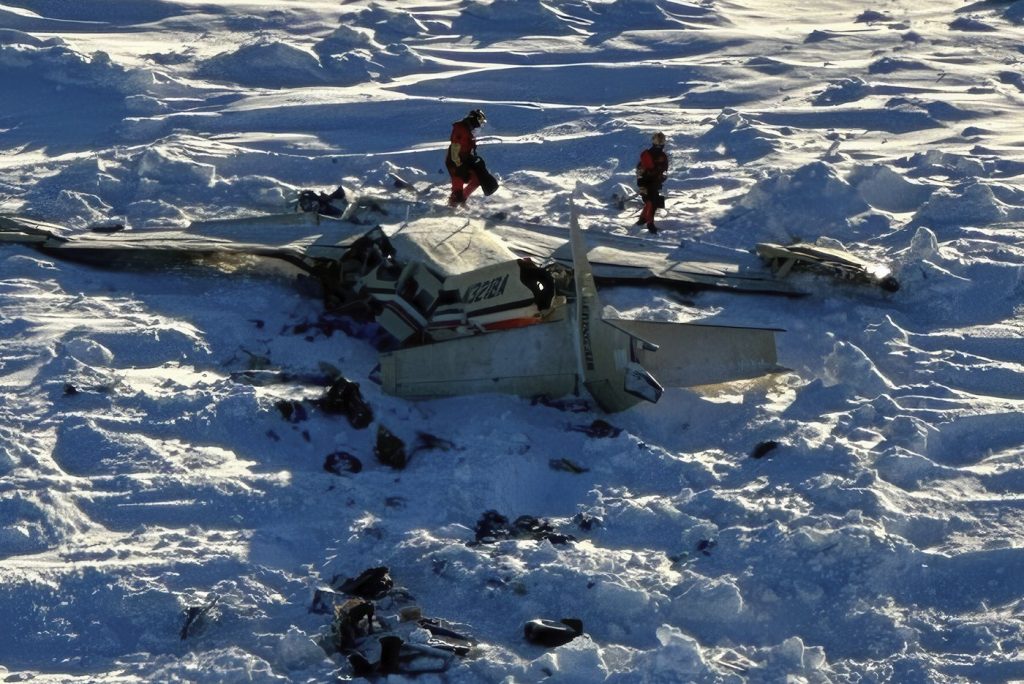Plane Crash in Western Alaska: Authorities Investigating Deadly Incident
JUNEAU, Alaska (AP) – Authorities are actively working to recover the wreckage of a tragic plane crash in western Alaska that resulted in the deaths of ten individuals. Investigators are focusing on uncovering the causes behind the small commuter aircraft's sudden descent into the icy waters of the Bering Sea.
The incident involves a single-engine turboprop plane, specifically a Cessna Caravan, which was on a scheduled commuter flight from Unalakleet to Nome. The aircraft disappeared from radar on Thursday afternoon, approximately 30 miles (48 kilometers) southeast of Nome. An extensive search operation was conducted, and the wreckage was located the following day, revealing there were nine passengers and the pilot onboard at the time of the crash.
Recovery efforts commenced quickly, with crews aiming to retrieve the wreckage and the remains of the deceased before the arrival of anticipated severe weather, including high winds and snow. Officials noted that this incident represents one of the deadliest plane crashes in Alaska in the past 25 years.
The loss of contact with the plane occurred less than an hour after its departure from Unalakleet. The aircraft was reported missing in the Bering Sea, prompting local, state, and federal agencies to collaborate in an extensive search. The wreck was discovered on Friday with the assistance of helicopter teams, who conducted aerial surveys of the icy waters and vast tundra in the vicinity.
To facilitate the removal of the wreckage, a Black Hawk helicopter will be deployed once the bodies have been recovered. Unalakleet, where the flight originated, is a small community of approximately 690 residents situated about 150 miles (about 240 kilometers) southeast of Nome and 395 miles (about 640 kilometers) northwest of Anchorage. Notably, the village sits on the historic Iditarod trail, famous for hosting the Iditarod sled dog race.
As for the ongoing investigation into the crash, the National Transportation Safety Board (NTSB) is sending specialists from multiple states to examine the situation. Radar data from the U.S. Civil Air Patrol indicated that the plane exhibited rapid loss of elevation and speed before contact was lost. However, officials from the U.S. Coast Guard have stated that there were no distress signals received prior to the incident. Such signals would typically trigger an emergency locating transmitter to alert rescue services, but no such alerts were registered.
In Alaska, flying is an essential means of transportation due to the expansive landscape and limited infrastructure. Many rural communities lack direct access to a developed road system, relying on air travel for everything from sports teams visiting rival schools to essential goods being delivered.
Among the victims were Rhone Baumgartner and Kameron Hartvigson, who had traveled to Unalakleet to work on a heat recovery system critical to the local water plant, as reported by the Alaska Native Tribal Health Consortium. The identities of the other eight victims have not yet been disclosed.
This tragic incident adds to a worrying trend, as it marks the third significant aviation-related mishap in the United States within just eight days. Prior incidents included a collision between a commercial jetliner and an Army helicopter near Washington, D.C., which claimed 67 lives, followed by a medical transport plane crash in Philadelphia that resulted in six fatalities along with one person on the ground.










